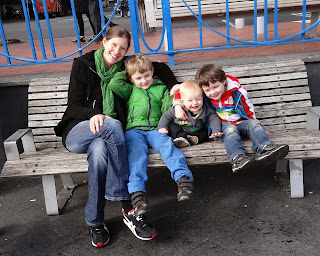I love baking with my kids. We also love watching those cheesy bake shows which make amateur contestants go against each other to see who can make the best (or worst) cake. This past week, my children and I decided to create our own show.
I got out enough bowls, wooden spoons, and equipment for each of my three children, gave them each 2 eggs, and ingredients. I had to film them each coming in to the kitchen, as they love to watch Youtube and wanted to have everything look and be commentated on as if were a real show.
Activity 1: Bake your own signature cake.
 |
| Three little hands mixing batter |
Then they all got to work. I led them through the basics, but let them do the heavy lifting. They had to grease and flour their own pans, measure and stir their own ingredients, and design their own cakes. It was fun and we had a blast.
My youngest, who is five, took the whole thing really seriously. When asked what kind of a cake he would make, he replied, “A waterfall cake made of chocolate with a Spinosaurus on it.” Not an easy task, if you ask me.
 |
| Waterfall cake with Spinosaurus |
Here are the final cakes and a recipe for only 1 round cake made with simple ingredients. I hope you enjoy yourselves as much as we did. This was a fantastic way for the whole family to get involved in the kitchen.
Recipe 1 Bake-off cake:
 |
| The final three cakes! |
Ingredients:
1/2 C Butter3/4 C Sugar
2 Eggs
1 t vanilla
1 1/2 C flour
1 1/2 t baking powder
pinch of salt
1/2 C milk
1/4 C cocoa (optional)
Your choice of frosting and decorations!
How to make the cake:
1. Have children grease and flour a round baking tin.2. First have children mix together the butter and sugar. Make sure your butter is nice and soft so that the kids can handle it.
3. Show how to break an egg and then let each add 2 eggs to their butter/sugar mixture and mix again.
4. Add vanilla, milk, and all dry ingredients. Mix well.
5. If you are going to make a chocolate cake, add a 1/4 C cocoa to the mix and perhaps a little bit more milk.
6. Bake at 350* F for 20-30 minutes or until a toothpick comes out clean.
7. Let cool and then decorate to your hearts content.
8. Don't forget to judge the best cake!
Please let me know how your cakes turned out!















































